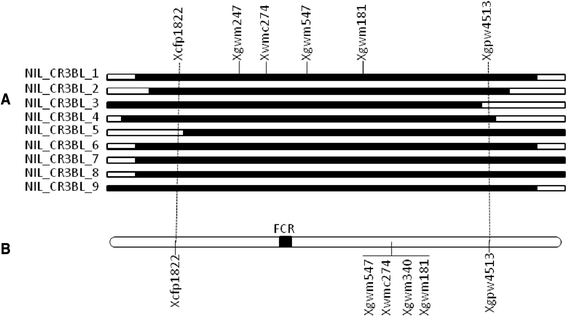Fine mapping of a large-effect QTL conferring Fusarium crown rot resistance on the long arm of chromosome 3B in hexaploid wheat
- PMID: 26493707
- PMCID: PMC4618961
- DOI: 10.1186/s12864-015-2105-0
Fine mapping of a large-effect QTL conferring Fusarium crown rot resistance on the long arm of chromosome 3B in hexaploid wheat
Abstract
Background: Fusarium crown rot (FCR) is a major cereal disease in semi-arid areas worldwide. Of the various QTL reported, the one on chromosome arm 3BL (Qcrs.cpi-3B) has the largest effect that can be consistently detected in different genetic backgrounds. Nine sets of near isogenic lines (NILs) for this locus were made available in a previous study. To identify markers that could be reliably used in tagging the Qcrs.cpi-3B locus, a NIL-derived population consisting of 774 F10 lines were generated and exploited to assess markers selected from the existing linkage map and generated from sequences of the 3B pseudomolecule.
Results: This is the first report on fine mapping a QTL conferring FCR resistance in wheat. By three rounds of linkage mapping using the NILs and the NIL-derived population, the Qcrs.cpi-3B locus was mapped to an interval of 0.7 cM covering a physical distance of about 1.5 Mb. Seven markers co-segregating with the locus were developed. This interval contains a total of 63 gene-coding sequences based on the 3B pseudomolecule, and six of them were known to encode disease resistance proteins. Several of the genes in this interval were among those responsive to FCR infection detected in an earlier study.
Conclusions: The accurate localization of the Qcrs.cpi-3B locus and the development of the markers co-segregating with it should facilitate the incorporation of this large-effect QTL conferring FCR resistance into breeding programs as well as the cloning of the gene(s) underlying the QTL.
Figures
Similar articles
-
Transcriptome and allele specificity associated with a 3BL locus for Fusarium crown rot resistance in bread wheat.PLoS One. 2014 Nov 18;9(11):e113309. doi: 10.1371/journal.pone.0113309. eCollection 2014. PLoS One. 2014. PMID: 25405461 Free PMC article.
-
QTL conferring fusarium crown rot resistance in the elite bread wheat variety EGA Wylie.PLoS One. 2014 Apr 28;9(4):e96011. doi: 10.1371/journal.pone.0096011. eCollection 2014. PLoS One. 2014. PMID: 24776887 Free PMC article.
-
Fine mapping of a Fusarium crown rot resistant locus on chromosome arm 6HL in barley by exploiting near isogenic lines, transcriptome profiling, and a large near isogenic line-derived population.Theor Appl Genet. 2023 May 26;136(6):137. doi: 10.1007/s00122-023-04387-x. Theor Appl Genet. 2023. PMID: 37233855 Free PMC article.
-
Validation and delineation of a locus conferring Fusarium crown rot resistance on 1HL in barley by analysing transcriptomes from multiple pairs of near isogenic lines.BMC Genomics. 2019 Aug 14;20(1):650. doi: 10.1186/s12864-019-6011-8. BMC Genomics. 2019. PMID: 31412765 Free PMC article.
-
Quantitative Trait Loci Conferring Leaf Rust Resistance in Hexaploid Wheat.Phytopathology. 2018 Dec;108(12):1344-1354. doi: 10.1094/PHYTO-06-18-0208-RVW. Epub 2018 Nov 2. Phytopathology. 2018. PMID: 30211634 Review.
Cited by
-
Genome-wide association analysis of Fusarium crown rot resistance in Chinese wheat landraces.Theor Appl Genet. 2023 Apr 7;136(5):101. doi: 10.1007/s00122-023-04289-y. Theor Appl Genet. 2023. PMID: 37027037
-
A TaSnRK1α-TaCAT2 model mediates resistance to Fusarium crown rot by scavenging ROS in common wheat.Nat Commun. 2025 Mar 15;16(1):2549. doi: 10.1038/s41467-025-57936-x. Nat Commun. 2025. PMID: 40089587 Free PMC article.
-
Validating a Major Quantitative Trait Locus and Predicting Candidate Genes Associated With Kernel Width Through QTL Mapping and RNA-Sequencing Technology Using Near-Isogenic Lines in Maize.Front Plant Sci. 2022 Jun 30;13:935654. doi: 10.3389/fpls.2022.935654. eCollection 2022. Front Plant Sci. 2022. PMID: 35845666 Free PMC article.
-
Fine mapping of a major QTL, qKl-1BL controlling kernel length in common wheat.Theor Appl Genet. 2024 Mar 5;137(3):67. doi: 10.1007/s00122-024-04574-4. Theor Appl Genet. 2024. PMID: 38441674
-
Characterisation of a 4A QTL for Metribuzin Resistance in Wheat by Developing Near-Isogenic Lines.Plants (Basel). 2021 Sep 7;10(9):1856. doi: 10.3390/plants10091856. Plants (Basel). 2021. PMID: 34579389 Free PMC article.
References
-
- Akinsanmi OA, Mitter V, Simpfendorfer S, Backhouse D, Chakraborty S. Identity and pathogenicity of Fusarium spp. isolated from wheat fields in Queensland and northern New South Wales. Crop Pasture Sci. 2004;55(1):97–107. doi: 10.1071/AR03090. - DOI
-
- Chakraborty S, Liu CJ, Mitter V, Scott JB, Akinsanmi OA, Ali S, et al. Pathogen population structure and epidemiology are keys to wheat crown rot and Fusarium head blight management. Australas Plant Pathol. 2006;35(6):643–655. doi: 10.1071/AP06068. - DOI
-
- Murray GM, Brennan JP. Estimating disease losses to the Australian wheat industry. Australas Plant Pathol. 2009;38(6):558–570. doi: 10.1071/AP09053. - DOI
-
- Mudge AM, Dill-Macky R, Dong Y, Gardiner DM, White RG, Manners JM. A role for the mycotoxin deoxynivalenol in stem colonisation during crown rot disease of wheat caused by Fusarium graminearum and Fusarium pseudograminearum. Physiol Mol Plant Pathol. 2006;69(1):73–85. doi: 10.1016/j.pmpp.2007.01.003. - DOI
Publication types
MeSH terms
LinkOut - more resources
Full Text Sources
Other Literature Sources
Miscellaneous



